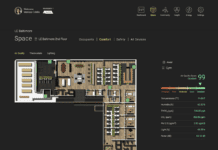In a continuing effort to stimulate market adoption of networked lighting controls (NLC), the DesignLights Consortium (DLC) last week released for comment a new version of its technical requirements for the energy saving- and smart building-enabling technology.
 The new draft Networked Lighting Control System Technical Requirements 5 (NLC5) further enhance requirements for listing systems on the DLC’s Networked Lighting Controls Qualified Products List (QPL), with multi-year plans addressing cybersecurity and system interoperability (including energy monitoring features of NLC systems). The DLC will accept comments on the proposal through March 17, 2020, then issue Draft 2 of the policy in April, and a final policy in June. The QPL informs the design of energy efficiency incentive programs for commercial and industrial (C&I) electric utility customers across the U.S. and Canada.
The new draft Networked Lighting Control System Technical Requirements 5 (NLC5) further enhance requirements for listing systems on the DLC’s Networked Lighting Controls Qualified Products List (QPL), with multi-year plans addressing cybersecurity and system interoperability (including energy monitoring features of NLC systems). The DLC will accept comments on the proposal through March 17, 2020, then issue Draft 2 of the policy in April, and a final policy in June. The QPL informs the design of energy efficiency incentive programs for commercial and industrial (C&I) electric utility customers across the U.S. and Canada.
“Continuing to raise the bar for NLC requirements delivers more capabilities and functionality to commercial customers through lighting. NLCs can optimize energy use and the quality of light provided to indoor and outdoor space,” DLC Executive Director and CEO Christina Halfpenny said. “The energy-saving promise of NLC s was highlighted in a 2018 DLC study that showed adding NLCs to LED lighting projects can boost energy savings by nearly 50 percent. Yet, much of these savings are untapped. By advancing our technical requirements, we aim to facilitate adoption of this transformative technology.”
In addition to cutting energy use and carbon emissions associated with C&I lighting, NLCs can be programmed to collect a wealth of data on space utilization, occupancy, and other factors — making them an ideal pathway toward smarter buildings that respond to the real-time needs of both facility managers and occupants.
First introduced in 2016, the DLC’s NLC Technical Requirements cover a range of capabilities that are either “required” or must be “reported” for a product to attain listing on the QPL. The DLC revises these requirements annually each June to keep pace with evolving technology and standards. The policy and associated QPL are essential resources for utility efficiency program administrators, and provide reliable, third-party verified data enabling lighting designers, specifiers, distributors, contractors, and end users to identify, compare, and select rebate-eligible, high-performing control systems.

NLC5 is part of a multi-year plan for continually advancing DLC listing requirements related to the cybersecurity, energy monitoring, and interoperability aspects of NLCs.
For example, while the 2019 version of the DLC’s NLC technical requirements established criteria for qualifying cybersecurity standards, NLC5 proposes to require that NLC products meet at least one of these standards for QPL listing (or reapply for listing with a one-year grace period). With a 2018 Center for Strategic and International Studies (CSIS) report pegging the cost of cybercrime at nearly $600 billion annually worldwide, enhancing the cybersecurity of networked lighting is intended to boost customer confidence and increase installations.
Likewise, enhancing requirements for product interoperability — the ability of various NLC systems to work together, typically facilitated by a shared set of information — is expected to make NLCs more attractive and valuable to C&I customers who may fear being locked into single-vendor proprietary systems. Strengthening energy monitoring features for NLCs, meanwhile, will better inform the design of utility efficiency programs and ground-truth manufacturer energy efficiency claims.
The new draft technical requirements are available to view in detail, with comments due March 17, 2020. Interested parties can visit this page on the DLC website.





















![[VIDEO] Collect Asset Data at the Speed of Walking a Building](https://facilityexecutive.com/wp-content/uploads/2024/02/maxresdefault-324x160.jpg)